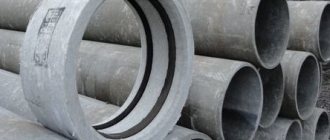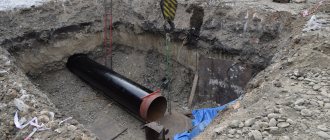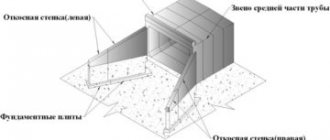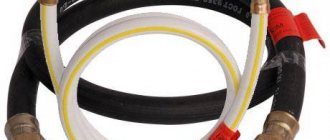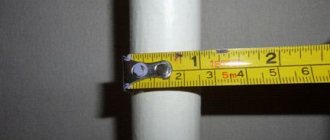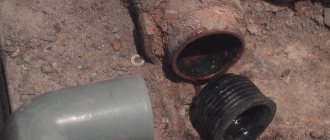When carrying out pipeline communications under roads and railways, protective pipe covers are used. Their task is to increase strength indicators and prevent damage to the steel shells of pipes under load from passing cars and trains.
The pipe case can be new, used, refurbished or used. The difference between these cases is their strength and durability. New protective shells have the greatest strength and durability, while used ones have the least. Before their use, pipes for protective cases undergo special preparation - they are coated with anti-corrosion protection, insulation and reinforcement elements.
Scope of application of the case using the HDD method
Installing the case by horizontal directional drilling allows you to preserve the natural landscape, is characterized by safety and low costs, because This method ensures the intersection of traffic intersections without opening the main road surface.
The method is used for laying communications during the repair of capital construction projects, under reservoirs, roads and railways. In this case, the maximum permissible distances from the casing to the base of the rails are taken into account. The cases are laid for water supply networks, gravity sewers, heating networks, and various product pipelines.
The main advantages of the method are the ability to mount large-diameter steel cases and high speed of work.
Cost of work on laying polyethylene pipes
The cost of work for each object is calculated individually and depends on the following indicators:
— length of the pipeline route;
— pipeline diameter;
— number and complexity of assembly units;
- laying method - laying pipes in a trench or trenchless laying method;
— remoteness of the object;
— presence or absence of electricity, etc.
The cost of the work is estimated after reviewing the design documentation or visiting the site by a specialist.
You can also send drawings or a pipe laying diagram by email. This will allow us to more accurately estimate the cost of work and materials (polyethylene pipes, bends, fittings, tees, valves or ball valves, bushings, flanges, electric couplings), and estimate the time frame for completing the work.
Calculation of the size and trajectory of laying a well under the casing
The route profile for HDD may include straight and curved sections. Bending radii are determined by the operational requirements for the installed communication. Designing a closed route requires taking into account the type and diameter of the pipeline and the type of equipment used. The angle of entry into the soil when using the HDD method depends on the construction conditions and is taken to be from 7 to 23º, the exit angle is 1-45º.
The length of straight sections increases with increasing depth of dense cohesive soils and the rigidity of the drill string. It is recommended to determine the geometric parameters of the route using the software used to prepare documentation. The length of the pipeline, the maximum and minimum bending radii of the drill rods are calculated using formulas taking into account the number of pipes being pulled.
Sections of the HDD pipeline at crossings through railways and roads with improved coverage must be laid in a protective casing. Its internal diameter must be at least 10 cm larger than the outer diameter of the pipeline. When determining the parameters of the case, the gap, guides and support devices are taken into account. When laying heating networks, sewerage, and water supply using the HDD method, high-pressure pipes must be enclosed in steel cases, the ends of which extend 10 m beyond the dimensions of the structures.
For drawn pipes, check:
- strength of structures and their connections;
- total tensile stresses;
- material tensile strength;
- the maximum permissible force for pulling communication.
The laying of pipelines for any purpose through the railway track is regulated by SNiP 32 01. Communications are located outside the neck of the stations at a distance of 20 m from the turnouts. Underground installation requires the installation of a case. The vertical distance from the protective pipe to the base of the rails must be at least 200 cm, and when driving HDD - 300 cm.
Laying a case under the road using horizontal drilling: purpose
The under-road casing is installed to protect communications from excessive pressure and vibration, especially under major highways. Without additional strengthening, such networks can collapse in just a couple of decades. Situations where the use of protective covers for pipelines is mandatory are described in state standards and construction documents. This is the installation of a gas pipeline in close proximity to water supply networks and power cables; laying pipes under major highways; intersection with railway tracks and tram rails.
Features of drilling a well for a casing using the HDD method
Trenchless construction is carried out in several stages:
- well drilling;
- increasing the diameter of the expander;
- installation of pipes.
Carrying out work using the HDD method involves using a drilling rig equipped with a special tip to which a flexible rod is connected. This element allows you to change the trajectory of the drill, which is important when drilling.
Periodic cooling of the tip is carried out through holes on the body of the installation. To adjust the penetration and detect obstacles in the ground, the tip is equipped with a navigator.
Methods for installing polyethylene pipes
Polyethylene pipes are installed mainly in three ways: using butt welding, electrofusion welding with embedded heaters, and using compression fittings. Pipe turns and branches are made using welded or cast fittings: bends, crosses, tees, bushings for flanges.
Butt welding of polyethylene pipes is usually used to connect HDPE pipes in all cases where it is possible to place pipes and welding equipment. Pipes of large diameters (from 630 mm) are also connected by butt welding.
Electrofusion welding, or welding using embedded heaters, is often performed in cramped conditions: in chambers and wells, in narrow trenches, etc.
Compression fittings allow you to create detachable connections for pipes with a diameter of up to 63 mm. The obvious advantage of such connections is simple and fairly quick installation without the use of special equipment. Compression fittings are most often used in the assembly of internal plumbing systems.
Stages of constructing a case using the HDD method
Before starting work, the technical documentation of the facility is transferred to the performers. Laying the casing using the HDD method involves the coordination of technical documentation with the owners of the areas where communications will be laid.
The contractor inspects the work site to assess the risk and clarifies the design profile of the excavation. After this, pipes are purchased.
Preparatory work for laying includes:
- installation of pits;
- fencing the work area;
- clearing strips along the highway;
- laying temporary roads;
- construction site and warehouse equipment.
Construction equipment is installed on a prepared foundation without a slope. The pit is fenced with railings and equipped with lighting. When the drill is initially immersed, the entry angle should be 10-20º. After reaching the depth specified by the project, drilling is carried out horizontally. The channel laid under the road surface is expanded with a device (rimmer), which is mounted in place of the drill head. Expansion is carried out in the opposite direction of penetration (from exit to entrance).
Drilling operations of this type can be carried out in difficult conditions. To decide whether a case is needed for HDD, the possibility of soil shedding should be assessed. Before you start pulling pipes into a well under the roadway, you need to consider the possibility of a reliable connection.
The diameter of the finished channel must exceed the diameter of the pipe by 30%. At high pressure inside the channel, the space between the outer wall of the pipe and the inside of the well is filled with a solution of bentonite (colloidal clay from minerals of the montmorillonite group). Its use helps prevent soil subsidence.
The HDD method is the best option for laying utility systems under transport routes. The technology is distinguished by its high economic effect, simplicity, and the highest possible accuracy. This type of work is regulated by building codes.
Our advantages
Own fleet of special equipment to perform drilling operations of any complexity
The construction site is organized in accordance with all standards and modern requirements
The drilling route is laid out by our surveyor, no additional payment is required from the client
The natural landscape remains untouched, the infrastructure around the construction site is not disturbed
During work under roads, traffic does not stop moving along them.
Work on digging pits is done free of charge and is not included in the total cost
Laying pipes underground
Naturally, for such an action it is necessary to initially design the future wire, and then proceed to the trench. Its depth must necessarily be greater than freezing in the cold season. Usually this is at least 1 m, while the trench is made 20 cm greater than the freezing depth. The calculation goes to the top of the pipe, because a shallow trench can lead to damage to the wire, even in the case of a temporary load.
If, nevertheless, conditions do not allow making a trench of exactly this depth, then it needs to be narrowed as much as possible to the width of the product itself along the bottom. It is also necessary to take into account the minimum slope - 0.005.
Rules for laying and installing polyethylene pipes
When installing polyethylene pipes underground, you must remember and follow the following rules. The depth of pipe laying should be 0.2 meters greater than the freezing depth of the ground (in the Moscow region this is 1.5 meters). The width of the trench along the bottom should be 40 centimeters greater than the diameter of the pipe being laid. If HDPE pipes are butt welded in a trench, its width should allow the welding machine to be placed there.
Before installing pipes, to avoid damaging them, the bottom of the trench must be carefully leveled. If the base of the trench has solid inclusions, it is necessary to arrange a sand cushion of sand 10-15 centimeters thick. When laying water supply pipes trenchless, there is no need for foundation and backfill.
After laying the pipes, backfilling is carried out. The initial sprinkling is done with sand, to a height of 15-30 centimeters above the top of the pipe. Further backfilling to the top of the trench can be done with local soil of stones or construction waste larger than 20 mm in size. Under the designed roads and driveways, the trench is backfilled exclusively with sand with layer-by-layer compaction.
Trenches
The gutters for laying the wire are made with the soil thrown in one direction, and on the other side the pipes are laid taking into account the connections, or they are additionally connected into strands. When connecting products directly in a trench, it is necessary to widen it at the joints of the products where the connecting equipment is supposed to be installed.
Connection of polyethylene pipes
It is also necessary to level the trench before installing the wire. In cases where the terrain is rocky or hard, it is necessary to make a sand cushion at the bottom with a layer of 20 cm. This will extend the life of the product. And will protect from possible damage.
In the case of small diameters, for example, up to 50 mm, the pipes are connected into a string and laid in small furrows formed, for example, by a plow blade.
Equipment for connecting polyethylene pipes
The trench must be buried in the cold season, while water is released through the pipes. This will reduce the stress from temperature changes in the wire itself.
Special fittings are attached to the bottom or walls of the well. In this case, the forces that arise with its help are not transferred to the pipes.
All connecting elements are mounted together with the pipeline laying. When installing connections (shaped or flanged parts), the occurrence of tensile stress must be observed. If done properly it shouldn't exist.
